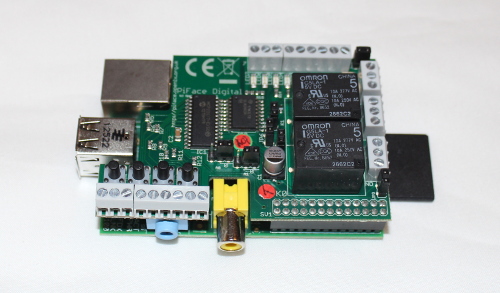- Home
- Learn Linux
- Learn Electronics
- Raspberry Pi
- Programming
- Projects
- LPI certification
- News & Reviews


20 November 2013
Normally my product reviews are based on items I have purchased. In this case I received a PiFace from Farnell / Element 14 as part of a product road test. I have already posted a road test review on the element 14 website.
I based my review on testing the board directly with the Raspberry Pi, but I had not used it in a real project. It has been a while since that review and since then I have created a project using the PiFace. There has also been some changes to the documentation and a new website for the PiFace since then which has improved on some of the documentation.
The PiFace is a digital input output board that fits on the top of the Raspberry Pi computer. The board provides an element of protection for the Raspberry Pi. Connections are made to external devices through screw terminals mounted on the board. This is easier than connecting wires to the GPIO ports on the Raspberry Pi.

The board provides a good selection of digital inputs (including 4 physical push-switches soldered on the board), digital outputs (including LED status indicators) and two relay outputs which switch between two different terminals (allowing them to be used as either normally open or normally closed). The relays can be disabled by removing some jumpers, which could be useful if you don't want them clicking on and off if not being used. The number of digital ports is sufficient for most projects, but it would have been useful to have some analog inputs. It's a much safer way of connecting electronics without risk of damaging the Raspberry Pi by overloading the GPIO port.
When installed the PiFace blocks all the GPIO ports, although it does not use all of them. One thing that they have created since is the PiFace rack which creates multiple GPIO connectors. I haven't tried the PiFace rack to see if it can be used for boards other than the PiFace cards, but I expect it can.
The documentation provided was a little limited, but this has been improved with the launch of the new PiFace website. There is now some good documentation and example projects for Python. It would be useful if they can provide some more documentation for Scratch though as this will increase the age range that this would appeal to.
As far as programming in Python and interfacing with digital electronic circuits the PiFace works really well. With it's small size and easy connections this can find an easy home in several projects and particularly useful for teaching young children or prototyping or creating semi-permanent projects without needing to solder.